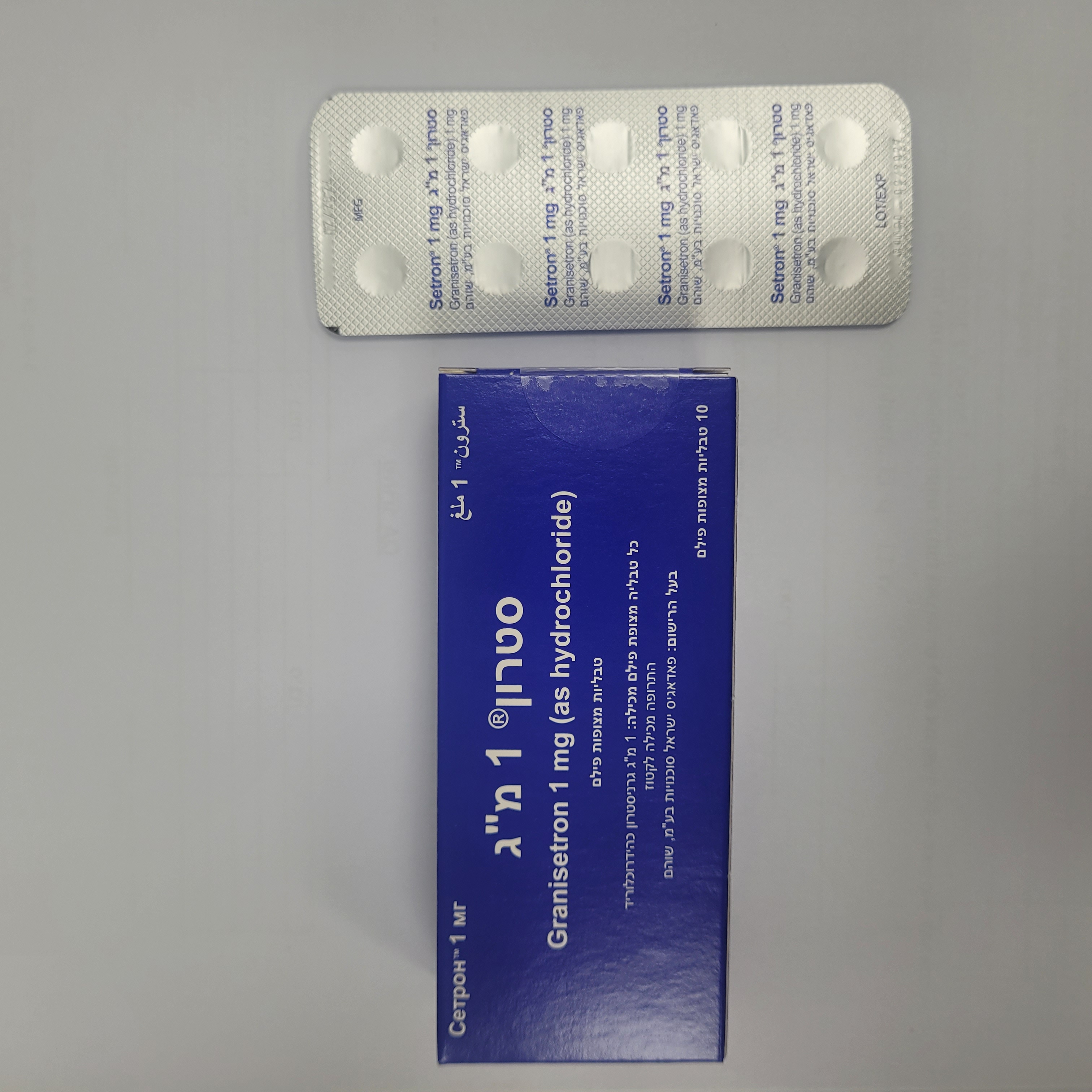Quest for the right Drug

סטרון 1 מ"ג SETRON 1 MG (GRANISETRON AS HYDROCHLORIDE)
תרופה במרשם
תרופה בסל
נרקוטיקה
ציטוטוקסיקה
צורת מתן:
פומי : PER OS
צורת מינון:
טבליות מצופות פילם : FILM COATED TABLETS
עלון לרופא
מינוניםPosology התוויות
Indications תופעות לוואי
Adverse reactions התוויות נגד
Contraindications אינטראקציות
Interactions מינון יתר
Overdose הריון/הנקה
Pregnancy & Lactation אוכלוסיות מיוחדות
Special populations תכונות פרמקולוגיות
Pharmacological properties מידע רוקחי
Pharmaceutical particulars אזהרת שימוש
Special Warning עלון לרופא
Physicians Leaflet
Pharmacological properties : תכונות פרמקולוגיות
Pharmacodynamic Properties
5.1 Pharmacodynamic properties Pharmacotherapeutic group: Antiemetics and antinauseants, Serotonin (5HT3) antagonists. ATC code: A04AA02 Neurological mechanisms, serotonin-mediated nausea and vomiting Serotonin is the main neurotransmitter responsible for emesis after chemo- or radio-therapy. The 5-HT3 receptors are located in three sites: vagal nerve terminals in the gastrointestinal tract and chemoreceptor trigger zones located in the area postrema and the nucleus tractus solidarius of the vomiting center in the brainstem. The chemoreceptor trigger zones are located at the caudal end of the fourth ventricle (area postrema). This structure lacks an effective blood-brain barrier, and will detect emetic agents in both the systemic circulation and the cerebrospinal fluid. The vomiting centre is located in the brainstem medullary structures. It receives major inputs from the chemoreceptor trigger zones, and a vagal and sympathetic input from the gut. Following exposure to radiation or cytotoxic substances, serotonin (5-HT) is released from enterochromaffine cells in the small intestinal mucosa, which are adjacent to the vagal afferent neurons on which 5HT3 receptors are located. The released serotonin activates vagal neurons via the 5-HT3 receptors which lead ultimately to a severe emetic response mediated via the chemoreceptor trigger zone within the area postrema. Mechanism of action Granisetron is a potent anti-emetic and highly selective antagonist of 5-hydroxytryptamine (5-HT3) receptors. Radioligand binding studies have demonstrated that granisetron has negligible affinity for other receptor types including 5-HT and dopamine D2 binding sites. Chemotherapy- and radiotherapy induced nausea and vomiting Granisetron administered orally has been shown to prevent nausea and vomiting associated with cancer chemotherapy in adults. Post-operative nausea and vomiting Granisetron administered orally has been shown to be effective for prevention and treatment of post- operative nausea and vomiting in adults. Pharmacological properties of granisetron Interaction with neurotropic and other active substances through its activity on P 450-cytochrome has been reported (see section 4.5). In vitro studies have shown that the cytochrome P450 sub-family 3A4 (involved in the metabolism of some of the main narcotic agents) is not modified by granisetron. Although ketoconazole was shown to inhibit the ring oxidation of granisetron in vitro, this action is not considered clinically relevant. Although QT prolongation has been observed with 5-HT3 receptor antagonists (see section 4.4), this effect is of such occurrence and magnitude that it does not bear clinical significance in normal subjects. Nonetheless it is advisable to monitor both ECG and clinical abnormalities when treating patients concurrently with drugs known to prolong the QT (see section 4.5).
Pharmacokinetic Properties
5.2 Pharmacokinetic properties Pharmacokinetics of the oral administration is linear up to 2.5-fold of the recommended dose in adults. It is clear from the extensive dose-finding programme that the antiemetic efficacy is not unequivocally correlated with either administered doses or plasma concentrations of granisetron. A fourfold increase in the initial prophylactic dose of granisetron made no difference in terms of either the proportion of patient responding to treatment or in the duration of symptoms control. Absorption Absorption of granisetron is rapid and complete, though oral bioavailability is reduced to about 60% as a result of first pass metabolism. Oral bioavailability is generally not influenced by food. Distribution Granisetron is extensively distributed, with a mean volume of distribution of approximately 3 l/kg. Plasma protein binding is approximately 65%. Biotransformation Granisetron is metabolized primarily in the liver by oxidation followed by conjugation. The major compounds are 7-OH-granisetron and its sulphate and glycuronide conjugates. Although antiemetic properties have been observed for 7-OH-granisetron and indazoline N-desmethyl granisetron, it is unlikely that these contribute significantly to the pharmacological activity of granisetron in man. In vitro liver microsomal studies show that granisetron's major route of metabolism is inhibited by ketoconazole, suggestive of metabolism mediated by the cytochrome P-450 3A subfamily (see section 4.5). Elimination Clearance is predominantly by hepatic metabolism. Urinary excretion of unchanged granisetron averages 12% of dose whilst that of metabolites amounts to about 47% of dose. The remainder is excreted in faeces as metabolites. Mean plasma half-life in patients is approximately 9 hours, with a wide inter-subject variability. Pharmacokinetics in special populations Renal failure In patients with severe renal failure, data indicate that pharmacokinetic parameters after a single intravenous dose are generally similar to those in normal subjects. Hepatic impairment In patients with hepatic impairment due to neoplastic liver involvement, total plasma clearance of an intravenous dose was approximately halved compared to patients without hepatic involvement. Despite these changes, no dosage adjustment is necessary (see section 4.2). Paediatric population These tablets are not recommended in children. Older people In elderly subjects after single intravenous doses, pharmacokinetic parameters were within the range found for non-elderly subjects.

שימוש לפי פנקס קופ''ח כללית 1994
Nausea & vomiting induced by cytostatic therapy. ירשם ע"י רופא אונקולוג לחולים אונקולוגיים בלבד
תאריך הכללה מקורי בסל
01/01/1995
הגבלות
תרופה מוגבלת לרישום ע'י רופא מומחה או הגבלה אחרת
מידע נוסף
